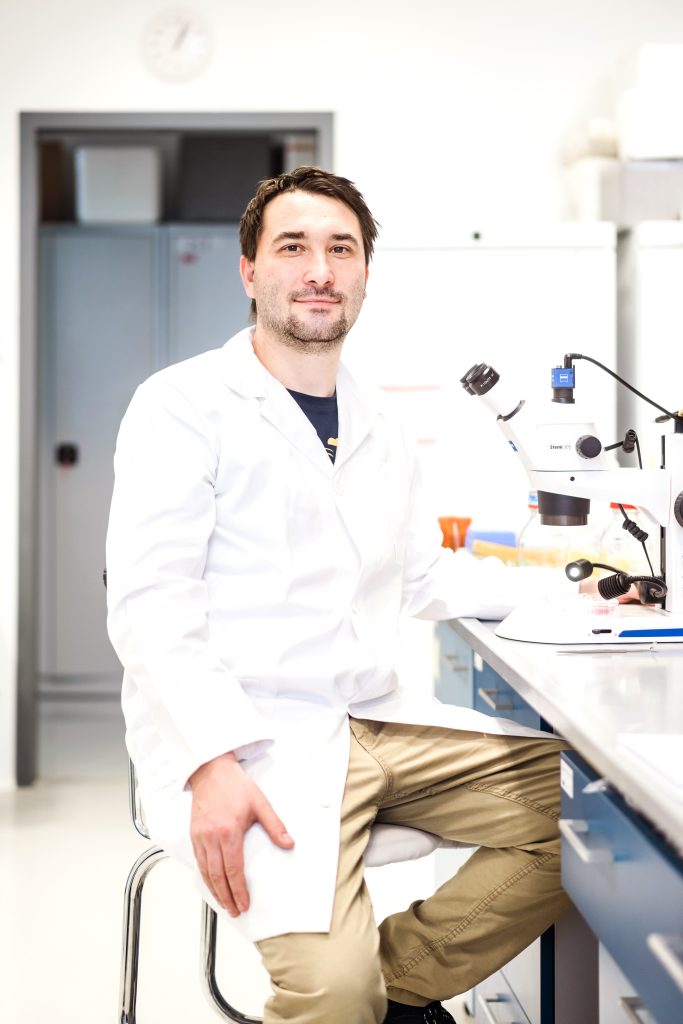Meet the new deputy director of the Czech Centre for Phenogenomics
Interview with Jan Procházka
Jan Procházka, PhD has been appointed as the new deputy director of the Czech Centre for Phenogenomics (CCP). Jan leads the Phenotyping Module aiming at standardized, systematic characterization of mouse models as well as preclinical research and development.
During his three-year postdoctoral fellowship at University of California Jan worked on tissue dynamics during craniofacial development. His current research focuses on the regulatory genes during development and under pathological situations with specific focus on rare genetic diseases.
We have asked Jan a few questions about the further development of the centre.

What direction do you think the CCP should take in the next five years?
In the next five years, the Czech Centre for Phenogenomics should focus on leveraging the rapid advancements in functional genomics to maintain our leadership in understanding the human genome. A key area of focus should be on patients with rare genetic diseases. By developing mouse avatar models, we can create highly accurate genetic models for testing new therapies, significantly speeding up the discovery of cures. Additionally, there is an immense potential in developing new gene therapy strategies. We are uniquely positioned to contribute to their preclinical validation, thereby accelerating their journey to clinical use. This strategy not only aligns with our expertise but also reflects our commitment to patient-centric research, being a part of a new era of personalized medicine and therapeutic innovation.
The CCP is increasingly focusing on preclinical research. How would you evaluate the cooperation with industry, what are their expectations from your centre and what can you offer them?
In terms of our activities with industrial partners, it’s important to recognize the complexities and specific needs that have emerged from our increased collaborations in recent years. While we strive to meet industry expectations, our foremost commitment is to scientific integrity. This means delivering authentic results, even if they diverge from initial expectations. Our unwavering dedication to rigorous research is not just a matter of principle but a critical factor in effective drug and treatment development. By optimizing strategies during the preclinical stage, we contribute to more efficient and cost-effective development pathways. Our Centre offers a comprehensive package for preclinical studies. We boast an experienced team capable of assisting with research, experimental design, study management, ensuring GLP compliance, and insightful data interpretation. We have established multiple models of human diseases from high burden diseases such as cardiovascular, metabolism and cancer with increasing number of precise genetic models for human rare genetic disorders. Additionally, we’re actively enhancing our interactions with legal authorities to streamline the transition from preclinical to clinical testing. This holistic approach not only meets industry needs but also upholds the highest standards of scientific research.
Is it not only in the European Union that the use of alternative animal models in research is increasingly discussed. What is your opinion on this issue?
In discussing the use of alternative animal models, I prefer the term ‘complementary non-animal models’ to avoid the misconception that these can completely replace animal models. In our pursuit to understand complex physiological processes and drug responses, animal models, enhanced by modern molecular genetics, remain indispensable for their closer approximation to human conditions. However, the potential of non-animal models as complementary research strategies is immense. These models offer scalability and cost-effectiveness, especially in high-throughput environments, enabling accelerated drug screening and repurposing. This approach aligns with our Centre’s forward-looking strategy.
Yet, there are practical challenges. Like animal models, non-animal models require a robust technological infrastructure and a team of highly skilled scientists. This necessitates a new funding approach and also brings demands for additional laboratory space and advanced technologies which need to be implemented to achieve robust and reliable use of non-animal models in the highest possible standards.
You are also very active in the popularization activities of the centre. You give regular lectures not only for children and students, you appear on radio and TV. Is this topic important to you and why?
Popularizing of our work is indeed very important to me, although as an introverted person, engaging in activities like TV appearances can be quite challenging. However, I strongly believe in the responsibility we carry as scientists, funded by public tax money, to communicate our work effectively to the public in an understandable way. Explaining the benefits and advancements of our research is not just a duty but a crucial part of our work.
Beyond this, there’s a broader purpose to these activities. The future of biomedicine and technology in general relies on the nurturing of highly educated, curious, and courageous scientists who are willing to continually push the boundaries of what’s possible. My engagement in educational activities, especially with young students, is driven by a desire to plant a seed of scientific interest and aspiration. Inspiring these young minds is not just about fostering future scientists; it’s about contributing to a world where scientific understanding and innovation continue to flourish, and maybe see more Nobel Prize winners and groundbreaking discoveries coming from Czech Republic.